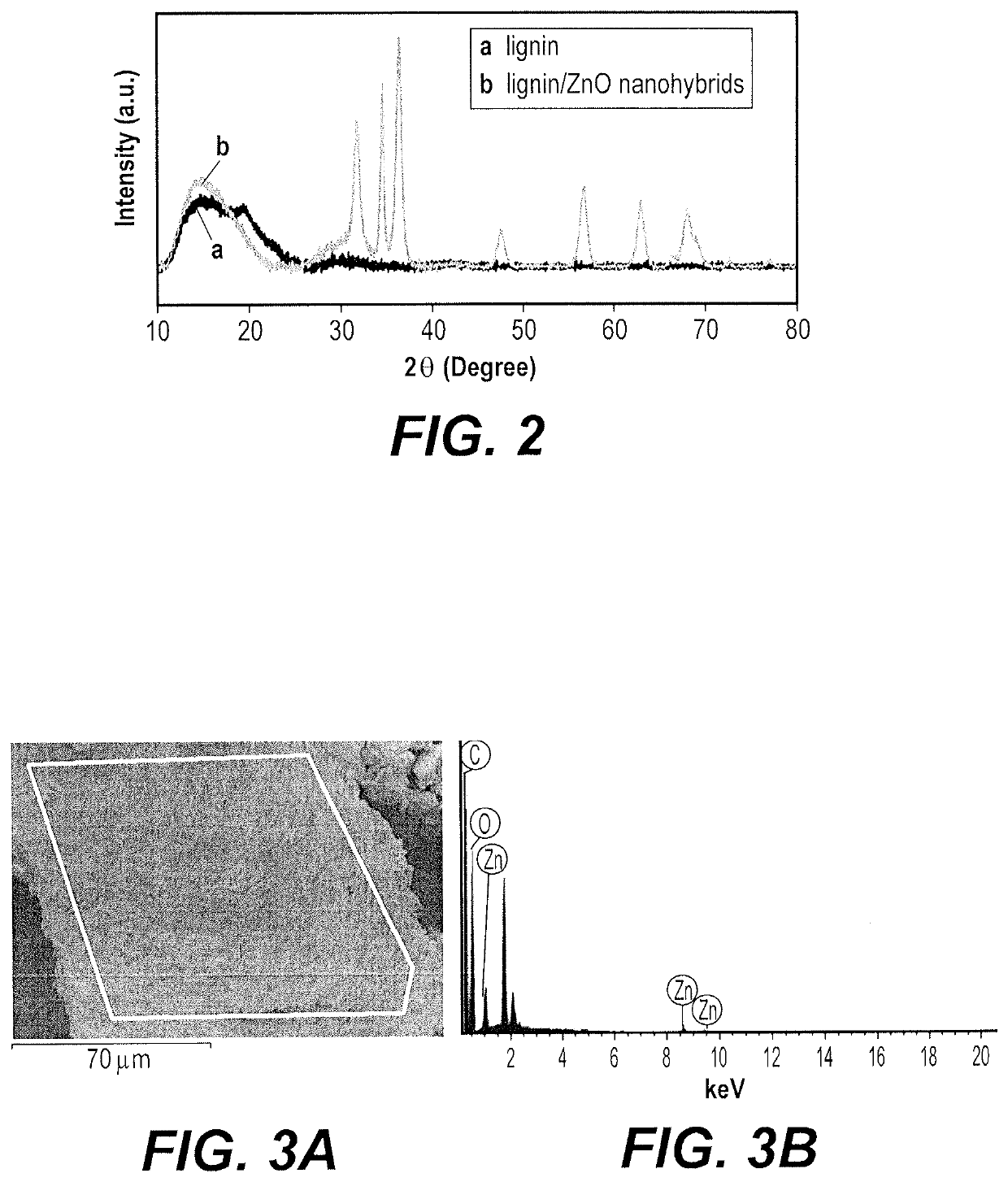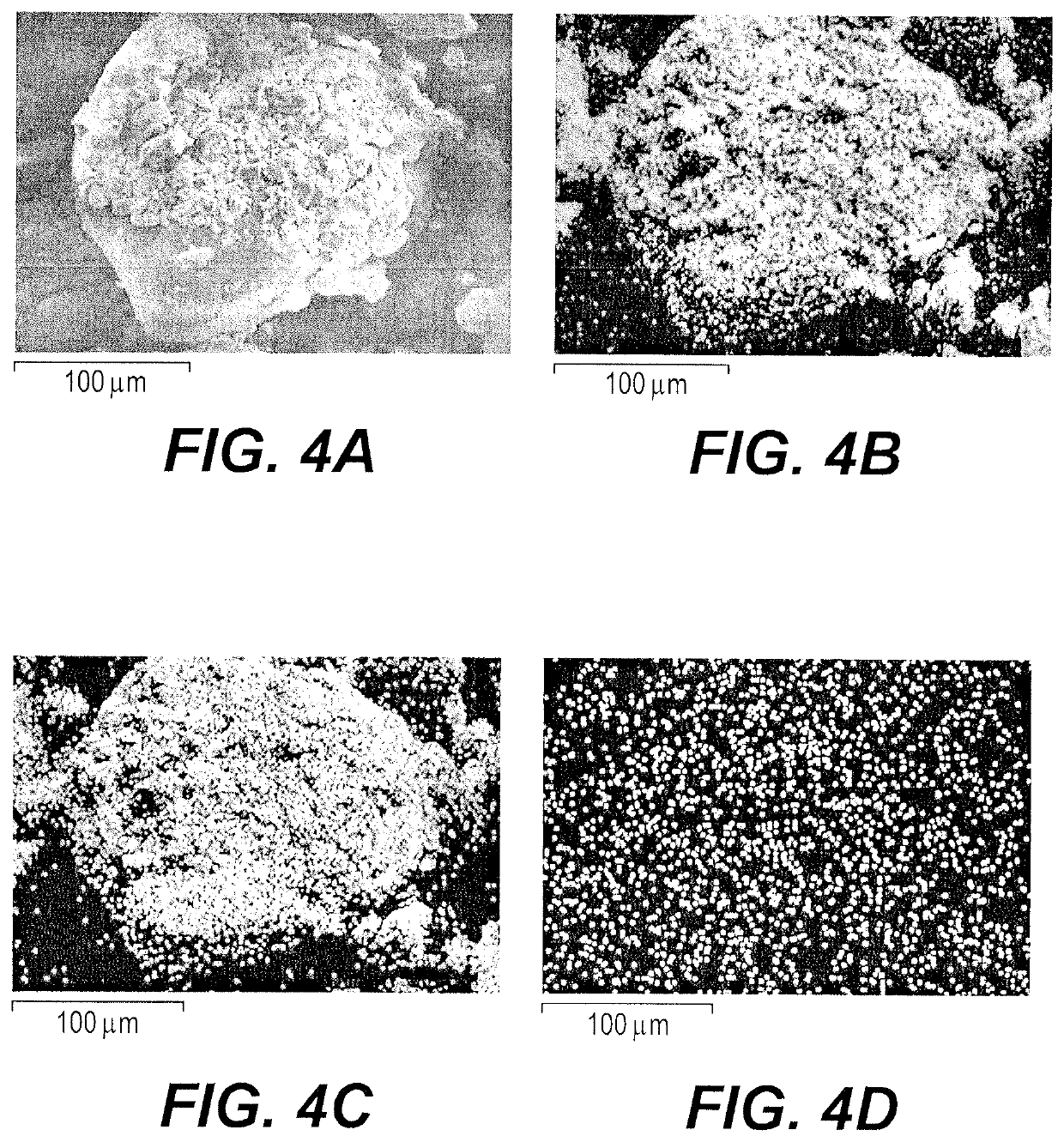Lignin-zinc oxide nanohybrid emulsion for UV protection
a technology of ligninzinc oxide and hybrid emulsion, which is applied in the field of uv protection, can solve the problems of adverse health and environmental effects, health risks and injuries, and natural sunscreens that do not shield the full uv light spectrum, and achieve the effect of blocking the transmission of uv radiation
- Summary
- Abstract
- Description
- Claims
- Application Information
AI Technical Summary
Benefits of technology
Problems solved by technology
Method used
Image
Examples
example 1
Synthesis of Lignin-Zinc Oxide Nanohybrids and Lignin-Zinc Oxide Nanohybrid Emulsion
[0025]A sample of Phoenix dactylifera biomass (composed primarily of leaves, i.e., leaflet, rachis, stalk, petiole, and spines) was collected from the King Saud University Campus, Riyadh (Saudi Arabia). The collected biomass was dried in a dark, room temperature environment, cut into small pieces, and pulverized in a blender to produce a biomass powder. About 25 g of biomass powder was immersed in 4% of 1 L sodium hydroxide alkali aqueous solution (40 g sodium hydroxide in 1 L water), and the biomass in solution was autoclaved at 120° C. for 2 hours under 15 lb of pressure, resulting in a black liquor with solids. The black liquor was separated by filtration through Whatman filter paper. The black liquor was pH adjusted to a pH of 2.0 using hydrochloric acid and kept at room temperature until a black precipitate formed in the pH-adjusted black liquor. The black precipitate was isolated by centrifugat...
example 2
Characterization of Lignin Nanohybrids and Lignin Nanohybrid Nanoemulsion
[0028]The morphology and chemical composition of the lignin emulsion and the lignin-zinc oxide nanohybrid emulsion were analyzed using Field Emission Scanning Electron Microscopy (FE-SEM) and Energy-Dispersive X-ray Spectroscopy (EDX) respectively. The formulation droplet size and stability was assessed using Dynamic Light Scattering (DLS) analysis.
[0029]UV spectra of the exemplary lignin-zinc oxide nanohybrids and the exemplary lignin-zinc oxide nanohybrid emulsion are shown in FIGS. 1A-1B. The lignin nanohybrids showed a peak at 275 nm, presumably due to intrinsic isolated lignin architecture (FIG. 1A). Also, the exemplary lignin-zinc oxide nanohybrid emulsion showed a broader peak between 290-300 nm.
[0030]The crystalline nature of the exemplary extracted lignin and exemplary lignin nanohybrids was assessed by XRD, as shown in FIG. 2. The lignin-zinc oxide nanohybrid data (dark grey) shows several sharp peaks...
example 3
UV Blocking Activity of Lignin Emulsion and Lignin-Zinc Oxide Nanohybrid Emulsion
[0034]Furthermore, the exemplary lignin-zinc oxide nanohybrids were used as a platform for a UV-blocking formulation by incorporation into an oil emulsion, as discussed previously. In the following examples, the oil used was coconut oil. Exemplary lignin-zinc oxide nanohybrid emulsion, exemplary lignin emulsion, coconut oil and isolated lignin were each prepared and their respective UV blocking activities were tested as follows (FIGS. 7-8).
[0035]Lignin-zinc oxide nanohybrid emulsion, lignin emulsion, oil alone or isolated lignin alone was applied to 3M Transpore Tape adhered to a clean quartz plate; for each measurement, one of lignin-zinc oxide nanohybrid emulsion, lignin emulsion, coconut oil and isolated lignin were spread over the entire surface of the 3M Transpore Tape, which was adhered to the clean quartz plate slowly with a thimble-coated finger. The sample-coated tape was then dried in a dark r...
PUM
| Property | Measurement | Unit |
|---|---|---|
| wavelengths | aaaaa | aaaaa |
| wavelength | aaaaa | aaaaa |
| wavelength | aaaaa | aaaaa |
Abstract
Description
Claims
Application Information
 Login to View More
Login to View More - R&D
- Intellectual Property
- Life Sciences
- Materials
- Tech Scout
- Unparalleled Data Quality
- Higher Quality Content
- 60% Fewer Hallucinations
Browse by: Latest US Patents, China's latest patents, Technical Efficacy Thesaurus, Application Domain, Technology Topic, Popular Technical Reports.
© 2025 PatSnap. All rights reserved.Legal|Privacy policy|Modern Slavery Act Transparency Statement|Sitemap|About US| Contact US: help@patsnap.com



